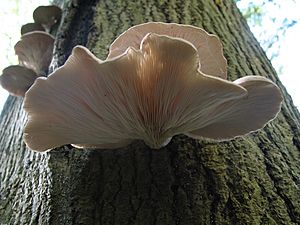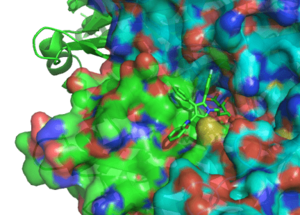Statin facts for kids
Quick facts for kids Statin |
|
|---|---|
| Drug class | |

Lovastatin, a medicine found in a type of mold, was the first statin sold.
|
|
| Class identifiers | |
| Synonyms | HMG-CoA reductase inhibitors |
| Use | High cholesterol |
| ATC code | C10AA |
| Biological target | HMG-CoA reductase |
| Clinical data | |
| Drugs.com | Drug Classes |
| External links | |
| MeSH | D019161 |
| Legal status | |
Statins are a type of medicine that helps people at high risk of heart and blood vessel problems. They are the most common drugs used to lower cholesterol.
Cholesterol is a waxy substance found in your blood. While your body needs some cholesterol, too much "bad" cholesterol (called LDL) can build up in your arteries. This buildup can make your arteries narrow and hard, a condition called atherosclerosis. This can lead to serious issues like heart attacks or strokes.
Statins work by lowering your LDL cholesterol. They are often used to prevent heart disease in people who are at high risk, or in those who have already had heart problems.
Like all medicines, statins can have side effects. These might include muscle pain, a slightly higher chance of getting diabetes, or changes in liver enzymes (chemicals in your liver). Very rarely, they can cause serious muscle damage.
Statins work by blocking an enzyme called HMG-CoA reductase. This enzyme is important for your body to make cholesterol. By blocking it, statins help lower the amount of cholesterol your body produces.
There are different kinds of statins, such as atorvastatin, fluvastatin, lovastatin, pitavastatin, pravastatin, rosuvastatin, and simvastatin. Sometimes, statins are combined with other medicines. Statins are on the World Health Organization's List of Essential Medicines, meaning they are considered very important for a basic health system.
Contents
Why Do People Take Statins?
Statins are mainly used to lower cholesterol and reduce the risk of diseases caused by hardened arteries. Doctors usually suggest healthy lifestyle changes first, like eating a balanced diet and exercising. If these changes aren't enough to lower cholesterol, statins can be very helpful.
The way statins are used can be split into two main groups: primary prevention and secondary prevention.
Preventing First-Time Heart Problems
For people who haven't had heart problems yet, statins can help prevent them. Guidelines suggest statins for adults aged 40 to 75 who have a high chance of heart disease in the next 10 years. Risk factors include unhealthy fat levels in the blood, diabetes, high blood pressure, and smoking.
Studies show that statins can lower the risk of death and other serious heart issues. For example, for every 138 people who take statins for 5 years, one less person dies. For every 49 people treated, one less person has a heart disease event.
Some guidelines recommend statins if your risk of heart disease is over 10% in 10 years. They are also suggested for adults with very high LDL cholesterol or those with diabetes. Doctors often talk with patients about the benefits and possible side effects before starting statins.
Preventing Future Heart Problems
Statins are very good at lowering the risk of death for people who already have heart and blood vessel disease. This includes people who have had a heart attack, stroke, or other artery problems.
On average, statins can significantly lower "bad" LDL cholesterol. This can lead to a big drop in the number of heart events (like heart attacks) and a reduced risk of stroke. Taking higher doses of statins can offer even more benefits.
Statins have also been studied for people having heart or blood vessel surgery. They can help reduce serious problems during and after these operations. Older adults who take statins after leaving the hospital for heart issues may also have a lower risk of future heart problems.
Statins for Kids and Teens
For children and teens with a condition called familial hypercholesterolemia (where high cholesterol runs in the family), statins can help lower their cholesterol levels. However, how safe they are for long-term use in children is still being studied. Some doctors suggest starting statins at age 8 if lifestyle changes don't work.
Familial Hypercholesterolemia
In people with familial hypercholesterolemia, statins are still a main treatment. However, they might be less effective at lowering LDL cholesterol, especially in severe cases. This is because these people often have problems with genes that help remove LDL from the blood. Other cholesterol-lowering methods might be needed along with statins.
Kidney Health and Statins
People with chronic kidney disease often have a higher risk of heart problems. Statins can help reduce the risk of death and major heart events in these patients, especially if they don't need dialysis. There is also evidence that statins can help protect kidneys during certain medical procedures, like heart imaging tests.
Statins and Asthma
Some research suggests that statins might help with asthma because they have anti-inflammatory effects. However, more studies are needed to be sure if they are effective and safe for treating asthma.
Possible Side Effects
| Condition | Often Recommended Statins | Why |
|---|---|---|
| People who have had a kidney transplant and take ciclosporin | Pravastatin or fluvastatin | These statins are less likely to cause problems with ciclosporin. |
| HIV-positive people taking certain HIV medicines | Atorvastatin, pravastatin or fluvastatin | Other statins might have more negative interactions. |
| People taking gemfibrozil, another cholesterol medicine | Atorvastatin | Combining gemfibrozil with a statin can increase the risk of serious muscle damage and kidney failure. |
| People taking the blood thinner warfarin | Any statin | The dose of warfarin might need to be adjusted, as some statins can make warfarin work stronger. |
The most common side effects of statins are muscle problems, a slightly increased risk of diabetes, and higher liver enzyme levels (which can mean liver damage). For every 10,000 people treated for 5 years, statins might cause about 75 cases of diabetes, 7.5 cases of bleeding stroke, and 5 cases of muscle damage. This might happen because statins block an enzyme needed for cholesterol, but also for other important body processes, like making Coenzyme Q10, which helps muscles work.
Other possible side effects include nerve problems or issues with the pancreas or liver. While some studies show very few side effects, others suggest they might be more common in real-world use than in controlled studies. Serious muscle problems, like rhabdomyolysis (muscle cell destruction), are very rare, happening in less than 0.1% of people. Rhabdomyolysis can lead to serious kidney injury.
Sometimes, people stop taking statins because of muscle pain or other symptoms. Studies have shown that some of these symptoms might be due to the nocebo effect. This means that if people expect to have side effects, they might actually feel them, even if the medicine itself isn't causing them. This is a challenge because statins are very important for preventing heart attacks and strokes.
Thinking and Memory
Many studies have looked at whether statins affect thinking and memory. Most research shows that statins do not cause memory loss or confusion. In fact, some studies suggest they might even help reduce the risk of dementia or Alzheimer's disease. However, some people have reported temporary memory issues or confusion, and the U.S. Food and Drug Administration (FDA) mentions this as a possible, non-serious side effect.
Muscles
About 10-15% of people taking statins report muscle problems, usually muscle pain. These numbers are higher in real life than in controlled studies. This difference might be due to the nocebo effect, where the expectation of harm can cause symptoms.
Serious muscle problems, like rhabdomyolysis, are very rare. This condition can damage muscles and lead to kidney problems. The risk of rhabdomyolysis increases with age, if other medicines like fibrates are taken, or if someone has an underactive thyroid.
Diabetes Risk
The link between statins and the risk of developing diabetes is still being studied. Higher doses of statins might slightly increase the risk, but the benefits of preventing heart disease usually outweigh this small risk. Statins might affect how cells take up sugar from the blood.
Cancer and Statins
Several studies have found that statins do not increase the risk of cancer. Some research even suggests they might lower the risk of certain cancers, like esophageal cancer, colorectal cancer, and liver cancer. They don't seem to affect the risk of lung cancer or breast cancer.
Drug Interactions
Taking statins with other cholesterol-lowering drugs, like fibrates or niacin, can increase the risk of muscle problems. Doctors will carefully monitor patients taking these combinations.
Eating grapefruit or drinking grapefruit juice can affect how some statins work. Grapefruit contains substances that can stop your body from breaking down certain statins, leading to higher levels of the medicine in your blood. This can increase the risk of side effects, including muscle damage. Because of this, it's often suggested to avoid grapefruit if you're taking certain statins.
Some HIV medicines (called protease inhibitors) can also increase statin levels in the blood, raising the risk of muscle injury. Doctors need to be careful when prescribing these medicines together.
How Statins Work
Statins work by blocking an enzyme called HMG-CoA reductase. This enzyme is like a gatekeeper in your body's cholesterol-making process. Statins are shaped very similarly to the natural substance that this enzyme works on. Because of this, statins fit into the enzyme's active spot and stop it from doing its job. This slows down the production of mevalonate, which is a step in making cholesterol.
Some statins are found naturally in things like Penicillium and Aspergillus fungi. These natural statins might help the fungi by stopping cholesterol-making enzymes in other tiny organisms they compete with.
Lowering Cholesterol Production
By blocking HMG-CoA reductase, statins stop your liver from making cholesterol. This is important because most of the cholesterol in your blood is made by your body, not just from the food you eat. When your liver makes less cholesterol, the levels in your blood go down. Since cholesterol is mostly made at night, some statins that don't stay in your body long are often taken in the evening to work best.
Increasing LDL Uptake
When your liver senses that it's not making enough cholesterol, it tries to get more from your blood. It does this by making more "LDL receptors." These receptors are like tiny magnets on the surface of liver cells. They grab onto "bad" LDL particles floating in your blood and pull them into the liver. Inside the liver, the cholesterol is broken down. This process helps to clear LDL cholesterol out of your bloodstream.
Other Benefits of Statins
Besides lowering cholesterol, statins might have other helpful effects. These are sometimes called "pleiotropic effects." For example, statins might:
- Improve how your blood vessels work.
- Help control inflammation in your body.
- Make the plaques (buildups) in your arteries more stable, so they are less likely to break off.
- Help prevent blood clots from forming.
Some studies have shown that statins can even help shrink the plaques in arteries. They might also benefit people who don't have high cholesterol but do have high levels of C-reactive protein, which is a sign of inflammation.
Types of Statins
Statins are divided into two main groups: those made through fermentation (like how some foods are made) and those made through chemical processes. Here are some common types:
| Statin | Image | Brand name | How it's Made | How it's Processed | How long it stays in the body |
|---|---|---|---|---|---|
| Atorvastatin | Lipitor, Torvast | Synthetic | CYP3A4 | 14–19 hours. | |
| Cerivastatin | Baycol (removed from market in 2001 due to serious muscle damage risk) | Synthetic | various CYP3A isoforms | ||
| Fluvastatin | Lescol | Synthetic | CYP2C9 | 1–3 hours. | |
| Lovastatin | Mevacor | Natural (from fungi, found in oyster mushrooms and red yeast rice) | CYP3A4 | 1–3 hours. | |
| Mevastatin | Compactin | Natural (from fungi, found in red yeast rice) | CYP3A4 | ||
| Pitavastatin | Livalo | Synthetic | CYP2C9 and CYP2C8 (a little) | ||
| Pravastatin | Pravachol | Fermentation-derived (from a bacterium) | Not through CYP enzymes | 1–3 hours. | |
| Rosuvastatin | Crestor | Synthetic | CYP2C9 and CYP2C19 | 14–19 hours. | |
| Simvastatin | Zocor | Fermentation-derived (from a fungus) | CYP3A4 | 1–3 hours. | |
| Atorvastatin + amlodipine | Caduet | Combination: statin + blood pressure medicine | |||
| Rosuvastatin + ezetimibe | Cholecomb | Combination: statin + cholesterol absorption blocker | |||
| Simvastatin + ezetimibe | Vytorin | Combination: statin + cholesterol absorption blocker |
Different statins have different strengths in lowering LDL cholesterol. For example, rosuvastatin and atorvastatin are generally more powerful than fluvastatin or pravastatin.

Some statins, like lovastatin, are found naturally in foods such as oyster mushrooms and red yeast rice. Studies have shown these foods can help lower cholesterol.
Many popular statin brands are now available as generic drugs. This means they are less expensive because their patents have expired.
| % LDL reduction (approx.) | Atorvastatin | Fluvastatin | Lovastatin | Pravastatin | Rosuvastatin | Simvastatin |
|---|---|---|---|---|---|---|
| 10–20% | – | 20 mg | 10 mg | 10 mg | – | 5 mg |
| 20–30% | – | 40 mg | 20 mg | 20 mg | – | 10 mg |
| 30–40% | 10 mg | 80 mg | 40 mg | 40 mg | 5 mg | 20 mg |
| 40–45% | 20 mg | – | 80 mg | 80 mg | 5–10 mg | 40 mg |
| 46–50% | 40 mg | – | – | – | 10–20 mg | 80 mg |
| 50–55% | 80 mg | – | – | – | 20 mg | – |
| 56–60% | – | – | – | – | 40 mg | – |
| Starting Dose Information | ||||||
| Starting dose | 10–20 mg | 20 mg | 10–20 mg | 40 mg | 10 mg; 5 mg if thyroid issues, >65, or Asian | 20 mg |
| If higher LDL reduction needed | 40 mg if >45% | 40 mg if >25% | 20 mg if >20% | – | 20 mg if LDL >190 mg/dL | 40 mg if >45% |
| Best time to take | Anytime | Evening | With evening meals | Anytime | Anytime | Evening |
History of Statins
Scientists learned about the link between cholesterol and heart disease in the mid-1900s. This led to efforts to lower cholesterol to prevent heart problems. At first, treatments included special diets and medicines that often had bad side effects.
In 1971, a Japanese biochemist named Akira Endo started looking for a better way to lower cholesterol. He thought that some tiny organisms might make substances that block the enzyme (HMG-CoA reductase) involved in cholesterol production. He found the first such substance, called mevastatin, from a fungus.
Mevastatin was never sold because it caused problems in lab animals. However, another scientist, P. Roy Vagelos from Merck & Co., was very interested. In 1978, Merck found lovastatin from a different fungus. This medicine was first sold in 1987 as Mevacor.
In the 1990s, people in the United States learned more about cholesterol. Other drug companies started making their own statins. In 1994, a study on simvastatin (sold as Zocor) showed amazing results: it reduced cholesterol by 35% and cut the risk of dying from a heart attack by 42%. By 1995, Zocor and Mevacor were huge successes.
Even though he didn't make money from his discovery, Akira Endo received major awards for his groundbreaking work. Scientists Michael S. Brown and Joseph L. Goldstein, who won the Nobel Prize for related cholesterol research, said that millions of lives saved by statins are thanks to Akira Endo.
Around 2016, some misleading claims about statin side effects spread in the media. This caused many people to stop taking their statins, which health experts believe could lead to more heart attacks and strokes. It's important to rely on scientific evidence when making health decisions.
Many statins are now available as generic medicines in the United States, making them more affordable.
Current Research
Scientists are still studying statins for other possible uses. They are looking into whether statins could help with conditions like dementia, lung cancer, or even cataracts. However, there isn't strong evidence yet to support using statins for conditions like pneumonia or multiple sclerosis.












